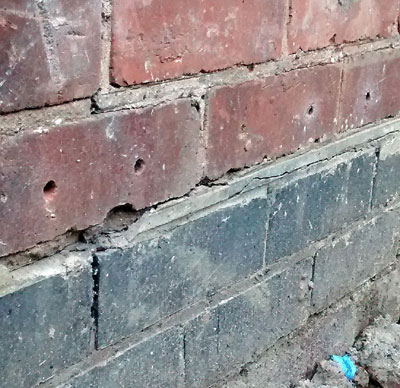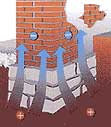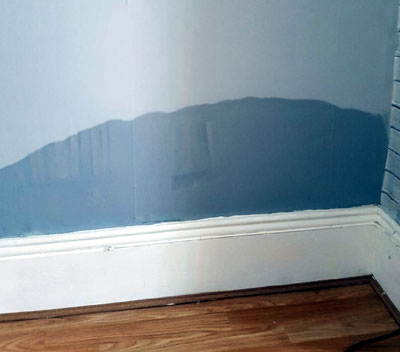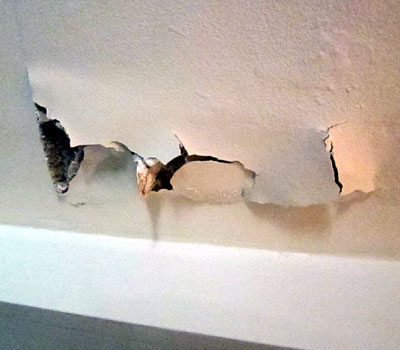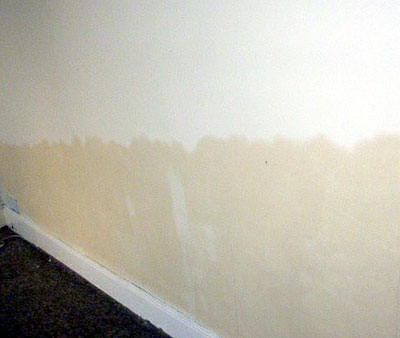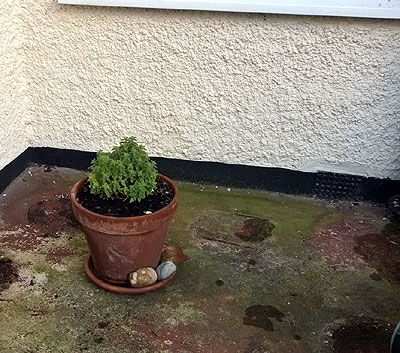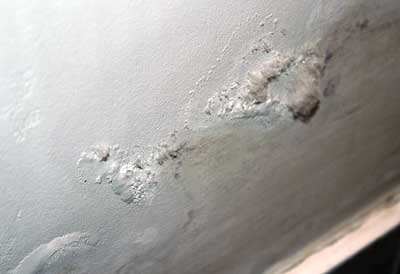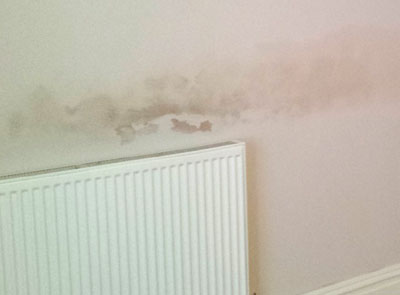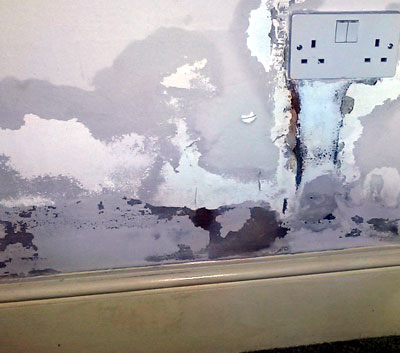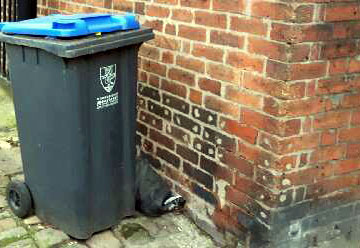Do any of the bogus statements below affect you and your building?
Contact us if you need help with damp - 01626 872886 .
If you'd like to send us the details of your problem complete our Dampness questionnaire.
We are long term members of the PCA - The Property Care Association - the professional body for the Damp Proofing industry and our Dampness Surveyors have over 50 years of experience between them.
Want Help choosing a Contractor - E: Mail us at help@propertyrepairsystems.co.uk
Misleading Statement 1.
Injected damp proof courses are always the answer - no, they are often not an answer to anything
I don't want to read a lot - click here for the most likely answer and solution
Although Chemical damp-proof courses should be installed in a position in accordance with good practice as described in BS 6576:1985, "Code of Practice for the Installation of Chemical Damp-proof Courses", a minimum of 150mm (6 inches) above external ground level, in external walls, often they are not. If the installer does not follow the basic rules the damp proof course will be useless.
Additional rules apply to cavity walls, vertical damp proof courses and internal walls. In most cases these rules are not followed.
The objective is to provide a water repellent or pore blocking material in a continuous horizontal band in the masonry, to act as an effective 'barrier' to water rising from the ground.
However, in most cases, even where such a barrier is installed, it achieves nothing for three reasons:
1. The moisture already above the damp proof course level will be evaporating through the plaster inside the building, depositing 'salts' of various types in the plaster, paint and paper. Installing a new damp proof course cannot reverse this process.
2. Some of the salts can be 'hygroscopic' - that means that they attract moisture from the air in the building. This process means that the wall will NEVER truly dry out.
3. Damp proofing work is often accompanied by replastering or even 'tanking' - these processes firstly add water to the wall, but worse they can cause the residual damp to be driven higher, because they reduce or eliminate evaporation at the surface. Only evaporation can dry out the wall, to some extent, depending on the degree of salt contamination.
Chemical Damp Proof Courses are usually injected into holes varying in diameter from 10mm to 22mm.
Sometimes these holes have been injected several times over the years, or new rows of holes have been drilled. Note the thicker mortar line where the original damp proof course is sitting - the loss of surface mortar is not significant and does not mean that the DPC is damaged - this can simply be repointed.
Also note the blue/black Engineering Bricks below the original DPC - these are very hard and tough and do not readily absorb water. There should be no need in this case to insert a new damp proof course.
Check the source of your damp for yourself - it is not difficult - click here
See our Article about installing different types of Damp Proof Course - click here.
See our Shop for damp proofing pumps and equipment - click here
For help with installation methods and rules call our experts on 01626 872886 .
The answer is usually:
That the dampness was caused by raised external ground levels or a water leak from a drain, a water main, a foul water pipe or a central heating pipe. We will help you or your Builder/Plumber to find the cause.
The solution is:
Lower the ground level, or find and fix the leak(s), remove the indoor plaster (if damaged) and fit our Mesh Membrane - then replaster. A Guaranteed result - guaranteed for 20 years.
Mesh Membrane - click here
Misleading Statement 2 - usually implicit
All Rising Damp is Natural - no, most of it is entirely man-made
'True' rising damp is entirely natural ground water rising by capillary action through porous building materials. The natural water in the ground under a building climbs up through the porous parts of the walls and floors up to the point where surface evaporation stops further climb.
This natural rising damp is extremely rare in buildings that have any kind of damp proof course - slate, bitumen or plastic. It will not normal climb very high - say 6 to 9 inches (150 to 225mm) above the skirting board and even that process will take tens of years.
And yet this is the only type of rising damp recognised by most Damp Proofing Specialists.
Man-made Rising Damp arises from water leaks and 'bridging' of the damp proof course. It is usually much more damp to the touch because more water, nearer to the surface is available, so the damage is more sudden and severe. This is the most common cause of ground floor damp symptoms in buildings today and it is not cured by installing a new damp proof course of any kind. Moisture can rise much higher (over a metre) and move much quicker (within days or weeks of a leak).
Above - Natural or Man Made Rising damp in Blue
Below - Man Made Rising Damp - water leak
Before spending money on any kind of damp proofing go to our Diagnosis page and check the source of your damp for yourself - we don't mind explaining - click here
For help with the causes of damp call our experts on 01626 872886 .
The answer is usually:
That the dampness was not Natural at all, but was caused by raised external ground levels or a water leak from a drain, a water main, a foul water pipe or a central heating pipe. We will help you or your Builder/Plumber to find the cause.
The solution is:
Misleading Statement 3 - usually no other cause is considered.Lower the ground level, or find and fix the leak(s), remove the indoor plaster (if damaged) and fit our Mesh Membrane - then replaster. A Guaranteed result - guaranteed for 20 years.
Mesh Membrane - click here
Rising Damp explains most problems - no, mostly it is a myth
Because most dampness problems in buildings are NOT caused by natural rising dampness. They are entirely Man Made!
In most cases they are caused by building defects, such as:
- water leaks inside the building - particularly in modern buildings fitted with plastic damp proof course and membrane materials
- water leaks under the building or from next door or the road - particularly in older buildings, built prior to the use of plastics
- 'bridging' of the damp proof course - mainly by paths, roads, steps and added structures
Before spending money on any form of damp proofing go to our Diagnosis page and check your damp for yourself - it is easy to read, non technical stuff - click here
For help with the MYTHS call our experts on 01626 872886 .
Typical example - yes the damp is rising, but it is not natural ground dampness
A water leak will be found next door - in this case, a leaking Main.
The answer is usually:
That the dampness was not Natural at all, but was caused by a water leak from a drain, a water main, a foul water pipe or a central heating pipe. Do not rule out leaks being from a neighboring property or road. Always look inside neighboring properties to be safe. We will help you or your Builder/Plumber to find the cause.
The solution is:
Find and fix the leak(s), remove the indoor plaster (if damaged) and fit our Mesh Membrane - then replaster. A Guaranteed result - guaranteed for 20 years.
Mesh Membrane - click here
Misleading Statement 4 - often stated in reports and estimates
House damp proof courses break down with age - no, actually, they don't
There is no evidence that Damp Proof Courses (DPCs) fail in service and yet a whole Industry has been created around this idea.
This may be because the outer edges of damp proof courses (visible as black lines between the bricks or stones) are not always hidden by the joint mortar, so can look a little ragged with age. This appearance has no bearing on their performance at all.Traditional damp proof courses (slate, stone, bitumen) do not break down inside the wall! There is nothing there to harm them, unless a Builder knocks out a hole for a new doorway. Neither do modern plastic DPCs break down - so never accept such a statement.
Inside the wall structure they are well protected, so they do not need replacement, unless mechanically damaged by a building alteration or ground movement.
Before spending money on any form of damp proofing go to our Diagnosis page and check your damp for yourself - there is nothing to lose - click here
For help with diagnosis call our qualified experts on 01626 872886 .
Below - some mortar has fallen out of the damp proof course edge - not a fault
Damp proof courses are not faulty just because the covering mortar falls out.
The answer is usually:
That the damp proof course did not break down, but that the dampness was caused by raised external ground levels or a water leak from a drain, a water main, a foul water pipe or a central heating pipe. We will help you or your Builder/Plumber to find the cause.
The solution is:
Lower the ground level, or find and fix the leak(s), remove the indoor plaster (if damaged) and fit our Mesh Membrane - then replaster. A Guaranteed result - guaranteed for 20 years.
Mesh Membrane - click here
Misleading Statement 5 - salts are rarely mentioned
Damp walls will dry out in time - no, often they will not, because of 'salts'
The only continuous pathways through which water can rise through a wall are the mortar beds: for water to pass, say, from brick to brick it must still cross a mortar bed. It is therefore essential that the damp-proofing material impregnates the mortar courses since these form the major pathway for the rise of water within walls. Damp-proofing the masonry units (e.g. bricks) porous tubes is of very little value!
Porous mortar and impervious/water repellent brickwork will still allow rising dampness to occur. However, if the pores in the mortar line are made water repellent or blocked then the water cannot rise since it cannot traverse the mortar beds to do so.
BUT, bear in mind that even if this new DPC was installed to perfection (unlikely) it will not deal with residual damp above the new DPC or the inevitable 'salt' contaminants, some of which suck moisture from the air.
Below - severe salts damage, plaster will not recover.
This damage requires the plaster to be hacked off completely.
Don't spend money yet - go to our Diagnosis page and check your damp for yourself - you have nothing to lose - click here
For help with how damp proof courses work call our experts on 01626 872886 .
The answer is usually:
That the salts will never dry out, even when the moisture source is removed. Some of them absorb moisture from the air - they are said to be 'hygroscopic'.
Replastering or rendering, or Tanking with liquids over salts will always fail.
The solution is:
Lower the ground level, or find and fix the leak(s), remove the indoor plaster to bare brick/stone, apply Salt Neutraliser and then fit our Mesh Membrane - then replaster. A Guaranteed result - guaranteed for 20 years.
Mesh Membrane - click here
Misleading Statement 6 - amazingly some 'specialists' offer this treatment!
A house that has a plastic modern DPC might need chemical injection - no, do not consider it
In many properties built since the 1950s plastic damp proof courses (DPCs) have been installed, incorporating plastic Damp Proof Membranes (DPMs) under the concrete floors. These two plastic layers are usually linked, to form a continuous plastic waterproof barrier to dampness from below the building. When correctly installed they are 100% effective. They do not suddenly fail.
So never accept the option of installing a Chemical Damp Proof Course in one of these buildings - some simple investigation will almost certainly find a water leak, usually internal, and these are usually covered by your Building Insurance.
Below - modern house, internal water leak.
This problem in a modern house NEVER requires to use of Tanking liquids, or the installation of a new Damp Proof Course.
Before spending money check your damp for yourself - we'll help you for free - click here
For help with types of damp proofing fluids and creams and where to use them call our experts on 01626 872886 .
Misleading Statement 7 - builders frequently build against walls - e.g. steps, decks.
You can safely cover over a damp proof course - no, this stops it from working properly
Care should be taken to ensure that the damp-proof course is not 'bridged' by high external ground levels, blocked cavities or debris piled against the wall; ground levels should be lowered, cavities cleaned out or the area below the damp-proof course might be 'tanked' internally if deemed necessary.
NOTE: Should minor bridging of an effective damp-proof course occur, for example by moderately porous plasterwork, then it is highly unlikely that the dampness would continue to rise to its potential height. Problems of this type together with defects in construction of the floor/wall junction usually manifest themselves at the base of the wall.
Before spending money on any form of damp proofing go to our Diagnosis page and check your damp for yourself - there is nothing to lose - click here
For help with 'bridging' and blocked cavities call our experts on 01626 872886 .
Below - concrete yard level too high relative to the damp proof course and Air Brick.
This will cause rain water splash up to penetrate the wall causing damp inside.
The answer is:
Building Regulations stipulate that ground levels should be at least 6 inches - 150mm - below the level of the damp proof course to prevent the lateral penetration of (rainwater splash up) dampness through the walls into the plaster and skirting boards.
The solution is:
Ideally lower the ground level, or, if that is not feasible, remove the indoor plaster and fit our Mesh Membrane - then replaster. A Guaranteed result - guaranteed for 20 years.
Mesh Membrane - click here
Misleading Statement 8.
Internal walls suffer from natural rising damp - no, only very, very rarely
In reality, walls that have no external outside face (said to be' internal' walls) are never likely to need damp proof injection - because they are never likely to suffer from natural rising damp.
Internal walls are most likely to suffer from water leaks under the floor - mains water, sewage (but note - there is unlikely to be a smell due to the filtering effect of the soil), or central heating leaks. Check all these systems first - see our Water Leak Testing section - click here.
If the internal wall is a shared wall (Party Wall) go next door and ask to see the matching area - the source may not be under your house.
Your House Insurance may cover the cost of repair - check your Insurance Excess and call the Insurer to advise them of the probable leak. Take lots of dated photographs as evidence.
Don't waste money on internal walls - go to our Diagnosis page and check your damp for yourself - save your money - click here
For help with types of damp proofing fluids and creams and where to use them call our experts on 01626 872886 .
The answer is usually:
That the dampness was caused by a water leak from a drain, a water main, a foul water pipe or a central heating pipe. We will help you or your Builder/Plumber to find the cause.
The solution is:
Find and fix the leak(s), remove the indoor plaster (if damaged) and fit our Mesh Membrane - then replaster. A Guaranteed result - guaranteed for 20 years.
Mesh Membrane - click here
Misleading Statement 9.
Cavity walls suffer from natural rising damp - no, but they can be partially blocked
Walls that have a cavity (usually in older houses about 1 inch - 25mm wide, but up to 4 inches - 100mm in modern houses) between the inner and outer bricks or blocks, however small that cavity is, are never likely to need damp proof injection - because they are never likely to suffer from natural rising damp - they will have been built with a damp proof course. A clean cavity gives good air flow between the walls and even if outside ground levels are a little high ('bridging' due to rainwater splash up) the evaporation inside the cavity will ensure that dampness does not travel through the inner leaf to spoil decorations.
Cavity walls are most likely to suffer from debris in the cavity or damp cavity insulation - see our Article about cavity walls - click here.
Your cavity may have been filled with foam, polystyrene beads or Rockwool. Ask the Installer to check for debris in the cavity - such debris allows moisture to move from outside to inside, both above and below the damp proof course. Rockwool may become soggy if enough dampness is trapped.
Ask for details of our Cavity Cleaning Method.
For help with types of damp proofing fluids and creams and where to use them call our experts on 01626 872886 .
The answer is usually:
That the dampness was caused by debris (mortar, sand, brick pieces, dirty wall ties, badly installed cavity insulation) and then the moisture from raised external ground levels or a water leak from a drain, a water main, a foul water pipe can cross the cavity from the outside Otherwise the problem may be an internal leak. . We will help you or your Builder/Plumber to find the cause.
The solution is:
Clean out the cavity, lower the ground level, or find and fix the leak(s), remove the indoor plaster (if damaged) and fit our Mesh Membrane - then replaster. A Guaranteed result - guaranteed for 20 years.
Mesh Membrane - click here
Misleading Statement 10.
Sand and cement render replastering, or Tanking, is best - sadly, often it is not
Walls that have damp inside for whatever reason, above the damp proof course, need good evaporation on both sides to ensure that dampness does not climb the walls any further by natural capillary action.
So called 'Tanking' a wall with a liquid sealer (paint or cement slurry) or applying a dense Render of sand and cement with 'waterproofer' will cut down or eliminate the essential evaporation that dries a wall out (they only dry very slowly - the Building Research Establishment (BRE) give an average of 0.5 to 1.0 inch (12.5mm to 25mm) of wall thickness per month, assuming that both sides of the wall can breathe)
Tanking and rendering result in the trapped moisture being driven higher over time - eventually the moisture will appear above the level of the Tanking or render and may show in the form of a 'salt band'.
The reason for the continued rise of moisture is simple - the so called 'rising damp' was not natural and the man made source has not been eliminated, so the new chemical damp proof course is ineffective.
Salts bursting through paint - Render or Tanking can drive this higher
Don't drive water up your wall behind a waterproof layer - go to our Diagnosis page and check your damp for yourself - save some money and time - click here
For help with types of damp proofing fluids and creams and where to use them call our experts on 01626 872886 .
Floating band of damp and salt emerging above renewed plaster on 'waterproofed' render.
Note the perfect plaster below the band - the problem has been concealed by the render backing coat.
The answer is usually:
That the dampness was caused by raised external ground levels or a water leak from a drain, a water main, a foul water pipe or a central heating pipe. Using Tanking to seal the wall simply causes the moisture to rise further. Even sand and cement render may mask the problem, but eventually dampness will appear above the renewed area. We will help you or your Builder/Plumber to find the cause.
The solution is:
Lower the ground level, or find and fix the leak(s), remove the indoor plaster (if damaged) and fit our Mesh Membrane - then replaster. A Guaranteed result - guaranteed for 20 years.
Mesh Membrane - click here
Misleading Statement 11.
Modern, perfect plastic DPCs cannot let moisture past - yes they can, but not as a liquid
A 100% effective DPC in a modern house is made of plastic and unlike a chemical damp proof course should be a total barrier to water trying to move upwards in a wall by capillary action. But when water is present below the plastic layer, usually in modern buildings due to an internal water leak above the floor membrane, it simply bypasses the damp proof layer by being sucked up via the plaster and the back of the tightly fitted wooden skirting board.
The same 'wicking' problem occurs in older buildings where water dampens the soil or concrete under a suspended floor - the water vapour rises in the air, condenses on the walls and climbs the faces of the bricks or blocks, past the DPC layer and into the wall via the plaster. The skirting boards also play their part in 'wicking' and often rot as a consequence.
Some buildings have received four new damp proof courses before anyone has realised that water under the floor cannot be resisted by installing chemical or physical damp proof courses in the walls.
Under suspended timber floors the air bricks may cope with some of this excess moisture, but eventually the moisture rots the timbers.
In flats with ' Beam and Block' floors there is no floor membrane under the beams, so the vapour condenses on the underneath of the concrete beams and blocks, soaking in easily, giving rise to extremely cold floors and massive condensation and mold problems in the ground floor flats.
For help with types of damp proofing fluids and creams and where to use them call our experts on 01626 872886 .
The answer is usually:
That the dampness was caused by a water leak from a drain, a water main, a foul water pipe or a central heating pipe under a suspended floor. The water vapour rising in the sub floor space then condensed on the walls, joists or beams and was subsequently 'sucked' up the wall, bypassing the edge of the plastic damp proof course such damp is usually drawn up the back of the skirting boards and into the skim finish plaster. On hacking off the plaster the wall behind is often found to be bone dry. We will help you or your Builder/Plumber to find the cause.
The solution is:
Find and fix the leak(s), remove the indoor plaster (if damaged) and fit our Mesh Membrane if the wall had become damp - then replaster. A Guaranteed result - guaranteed for 20 years.
Mesh Membrane - click here
Misleading Statement 12.
Old buildings are likely to need a chemical damp proof course - no, they are not
Traditional damp proof courses (slate, stone, bitumen) do not break down!
So any property that has one - say from about 1880 onwards - is unlikely to need injection.
Buried inside the wall structure they do not significantly break down, so do not need replacement.
There is no evidence that they fail in service and yet a whole industry has been created around this idea.
Buildings constructed after 1950 are even less likely to need injection and those built from the 1960s onwards had plastic DPCs, so should never need a chemical version.
Send us photos of your property for DPC identification - you probably need nothing - click here
For help with diagnosis call our experts on 01626 872886 .
Below - repaired plaster over previous dampness,
This needs investigation - buildings do not suffer sudden patches of damp proof course failure.
The answer is usually:
That the dampness was caused by raised external ground levels or a water leak from a drain, a water main, a foul water pipe or a central heating pipe. We will help you or your Builder/Plumber to find the cause.
The solution is:
Lower the ground level, or find and fix the leak(s), remove the indoor plaster (if damaged) and fit our Mesh Membrane - then replaster. A Guaranteed result - guaranteed for 20 years.
Mesh Membrane - click here
Why not just give in and have a new DPC - because it damages your walls and wastes money
1. Analyse the problem - see our page - click here
2. Eliminate the faults - usually water leaks or high ground levels.
3. Remove the affected plaster and fit our Mesh Membrane - then replaster or plasterboard - see our Membrane Shop - click here
The Mesh Membrane is vented so that air can pass behind it - it is NOT a Tanking System - it does not seal the wall, so dampness is not driven higher.
For help with types of damp proofing fluids and creams and where to use them call our experts on 01626 872886 .
Below - multiple inject attempts - some properties now have five damp proof courses
Misleading Statement 13.
Rising damp can be confirmed using a Damp Meter - no it cannot, do not be fooled
Natural Rising damp is very, very difficult to confirm. It requires the use of Laboratory Testing and wall samples taken from multiple locations for each wall.
So when a local 'expert' or 'specialist' using a so-called Damp Meter advises you that you have Rising Damp and offers to inject and replaster the walls, ask them if they have any qualifications and if they have read this book.
Quick DIY Master Class in Dampness and Condensation - Click here to buy the reprint.
This book was written by Graham Coleman, who is a Lecturer in dampness and who has set many of the examinations.
He confirms in his book that a Damp Meter is not be be used to confirm that rising damp is present and he also explains how proper tests can be performed.
In practice these tests are rarely needed - simpler, less expensive options exist - but in 'legal' Cases Graham is often involved as an Expert Witness.
Click here to see our Dampness Guide for using a Damp Meter. - page 1
Click here to see our Dampness Guide for using a Damp Meter. - page 2
Misleading Statement 14.
Cavity wall insulation cannot cause damp inside the building - it can and it does
Walls in older houses that have cavities about 1 inch to 2 inches - 25mm to 50mm wide between the inner and outer bricks or blocks should not be filled with anything unless they have been checked in many places and are clear of debris and bridging. A clean empty cavity gives good air flow between the walls and even if outside ground levels are a little high ('bridging' due to rainwater splash up) or there is some debris present the evaporation inside the cavity will ensure that dampness does not travel through the inner leaf to spoil decorations indoors.
See our Article about cavity walls - click here.
Your cavity may have been filled with foam, polystyrene beads or Rockwool. Ask the Installer to check for debris in the cavity - such debris allows moisture to move from outside to inside, both above and below the damp proof course. Rockwool may become soggy if enough dampness is trapped.
Ask for details of our Cavity Cleaning Method.
For help with types of damp proofing fluids and creams and where to use them call our experts on 01626 872886 .
The answer is usually:
That the dampness was caused by debris (mortar, sand, brick pieces, dirty wall ties, badly installed cavity insulation) and then the moisture from raised external ground levels or a water leak from a drain, a water main, a foul water pipe can cross the cavity from the outside Otherwise the problem may be an internal leak. We will help you or your Builder/Plumber to find the cause.
The solution is:
Clean out the cavity, lower the ground level, or find and fix the leak(s), remove the indoor plaster (if damaged) and fit our Mesh Membrane - then replaster. A Guaranteed result - guaranteed for 20 years.
Mesh Membrane - click here
Property Care Association
We are long term members of the PCA - The Property Care Association - the professional body for the Damp Proofing industry and our Dampness Surveyors have over 50 years of experience between them.
If you prefer to use a Contractor, rather than our free advice service, then go to the PCA Website where you can find the nearest qualified specialist companies. They should give you the same information that we provide. If in doubt E Mail their Reports to us for checking, before spending any money.
Link for the PCA - click here.
Want Help choosing a Contractor - E: Mail us at help@propertyrepairsystems.co.uk
Index Page | Privacy Policy | Returns Policy | Contact | Links | Technical References
OUR SHOPPING PAGES
- DAMP SHOP - this Site, for Damp problem solving in buildings
- TANKING SHOP - this Site, for Damp problems below ground level
- MOLD SHOP - this Site, for Mold problems and their solutions
- SURVEYING TOOLS SHOP - this Site, for tools for surveying your building for damp
- DAMP PROOFING EQUIPMENT SHOP - pumps, injection rods, spray lances
Property Repair Systems
T: 01626 872886
E: Mail us help@propertyrepairsystems.co.uk
Site written by: David Moore
David Moore, B.A. (Hons.), C.T.I.S., C.R.D.S. Technical Author
Google+
Other Property Repair Systems Sites:
www.boron.org.uk - how to use Boron based insecticides/fungicides to treat timber rots and insect attack
www.deck-treatment.co.uk - how to treat patio decks and yacht decks
www.dryrot.biz - how to kill Dry Rot in buildings
www.drywallandfloor.co.uk - membranes for lining damp walls, floors, basements and cellars
www.epoxy-info.co.uk - resins for repairing and sealing all types of masonry
www.fire-door-paint.co.uk - upgrade doors to 30 minutes fire resistance
www.joist-repair.co.uk - how to quickly repair joists and beams of any size
www.propertyrepairsystems.co.uk - our Home Site
www.steel-fire-paint.co.uk - treat steel with Intumescent Paint to provide fire protection
www.timber.org.uk - systems of repair, with step by step methods
www.timber-repair.co.uk - how to repair timber beams
www.woodworm-info.co.uk - how to kill and prevent woodworm and death watch beetle
www.woodworm-expert-advice-forum.org.uk - all your questions and our answers about woodworm treatment DIY
